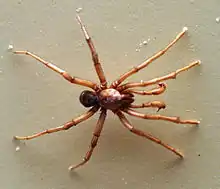| Idiosoma | |
|---|---|
 | |
| Idiosoma planites | |
| Scientific classification | |
| Domain: | Eukaryota |
| Kingdom: | Animalia |
| Phylum: | Arthropoda |
| Subphylum: | Chelicerata |
| Class: | Arachnida |
| Order: | Araneae |
| Infraorder: | Mygalomorphae |
| Family: | Idiopidae |
| Genus: | Idiosoma Ausserer, 1871[1] |
| Type species | |
| I. sigillatum (O. Pickard-Cambridge, 1870) | |
| Species | |
|
29, see text | |
| Synonyms[1] | |
| |
Idiosoma is a genus of Australian armoured trapdoor spiders that was first described by Anton Ausserer in 1871.[3] Originally placed with the Ctenizidae, it was moved to the armoured trapdoor spiders in 1985.[4] The name is derived from the Greek ἴδιος (idios), meaning "individual, unique", and σῶμα (soma), meaning "body", referring to the distinctive structure of the abdomen.[3]
Description
The skin of their abdomen is hardened, with a flattened end and deep grooves running along the sides. The thickened skin helps to reduce water loss in its dry habitat. It also serves as a kind of plug to shield itself from predators. This phenomenon is called phragmosis and occurs in perfection in the spider genus Cyclocosmia (Ctenizidae). However, some parasitic wasps have evolved paper-thin abdomens and long, slender ovipositors and lay their eggs on the softer skin at the front of the spider's abdomen.[5]
Females of the black rugose trapdoor spider (Idiosoma nigrum) can grow up to 30 millimetres (1.2 in) long. Males can grow up to 18 millimetres (0.71 in) in body length.
Behaviour
The spider digs burrows up to 32 centimetres (13 in) deep, where the temperature is relatively constant through the seasons. When prey triggers any of the trip-lines radiating from the burrow's entrance, the spider runs out of the burrow to capture ants, beetles, cockroaches, millipedes or moths. This is unlike many trapdoor spiders that very rarely leave their burrow. Males actively look for females, and mating takes place in the female's burrow. She lays her eggs during late spring and early summer. The spiderlings hatch in mid-summer, and stay inside the burrow until early winter, when the weather becomes more humid.[5]
Species
As of May 2019 the genus contained twenty-nine species from the states of New South Wales (NSW), South Australia (SA), Victoria (VIC) or Western Australia (WA):[1]
- Idiosoma arenaceum Rix & Harvey, 2018 – WA
- Idiosoma berlandi (Rainbow, 1914) – NSW
- Idiosoma castellum (Main, 1986) – WA
- Idiosoma clypeatum Rix & Harvey, 2018 – WA
- Idiosoma corrugatum Rix & Harvey, 2018 – SA
- Idiosoma cupulifex (Main, 1957) – WA
- Idiosoma dandaragan Rix & Harvey, 2018 – WA
- Idiosoma formosum Rix & Harvey, 2018 – WA
- Idiosoma galeosomoides Rix, Main, Raven & Harvey, 2017 – WA
- Idiosoma gardneri Rix & Harvey, 2018 – WA
- Idiosoma gutharuka Rix & Harvey, 2018 – WA
- Idiosoma incomptum Rix & Harvey, 2018 – WA
- Idiosoma intermedium Rix & Harvey, 2018 – WA
- Idiosoma jarrah Rix & Harvey, 2018 – WA
- Idiosoma kopejtkaorum Rix & Harvey, 2018 – WA
- Idiosoma kwongan Rix & Harvey, 2018 – WA
- Idiosoma manstridgei (Pocock, 1897) – WA
- Idiosoma mcclementsorum Rix & Harvey, 2018 – WA
- Idiosoma mcnamarai Rix & Harvey, 2018 – WA
- Idiosoma montanum (Faulder, 1985) – NSW
- Idiosoma nigrum Main, 1952 – WA
- Idiosoma occidentale (Hogg, 1903) – WA
- Idiosoma planites (Faulder, 1985) – NSW
- Idiosoma rhaphiduca (Rainbow & Pulleine, 1918) – WA
- Idiosoma schoknechtorum Rix & Harvey, 2018 – WA
- Idiosoma sigillatum (O. Pickard-Cambridge, 1870) (type) – WA
- Idiosoma smeatoni (Hogg, 1902) – SA
- Idiosoma subtriste (O. Pickard-Cambridge, 1877) – SA
- Idiosoma winsori (Faulder, 1985) – VIC
References
- 1 2 3 "Gen. Idiosoma Ausserer, 1871". World Spider Catalog Version 20.0. Natural History Museum Bern. 2019. doi:10.24436/2. Retrieved 2019-06-12.
- 1 2 Rix, M. G.; et al. (2017). "The Australasian spiny trapdoor spiders of the family Idiopidae (Mygalomorphae: Arbanitinae): a relimitation and revision at the generic level". Invertebrate Systematics. 31 (5): 590. doi:10.1071/IS16065. S2CID 90787136.
- 1 2 Ausserer, A. (1871). "Beiträge zur Kenntniss der Arachniden-Familie der Territelariae Thorell (Mygalidae Autor)". Verhandlungen der Kaiserlich-Königlichen Zoologisch-Botanischen Gesellschaft in Wien. 21: 117–224 [150].
- ↑ Raven, R. J. (1985). "The spider infraorder Mygalomorphae (Araneae): Cladistics and systematics". Bulletin of the American Museum of Natural History. 182: 138. hdl:2246/955.
- 1 2 Australian Museum Online
Further reading
- Australian Museum Online (2003): Black Rugose Trapdoor Spider fact sheet — with picture
- Main, Barbara York (1952): Notes on the genus Idiosoma, a supposedly rare Western Australian trap-door spider. W. Aust. Nat. 3: 130–137.
- Main, Barbara York (1957): Biology of aganippine trapdoor spiders (Mygalomorphae: Ctenizidae). Aust. J. Zool. 5: 402–473.
- Main, Barbara York (1985): Further studies on the systematics of ctenizid trapdoor spiders: A review of the Australian genera (Araneae: Mygalomorphae: Ctenizidae). Aust. J. Zool. (suppl. Ser.) 108: 1-84.